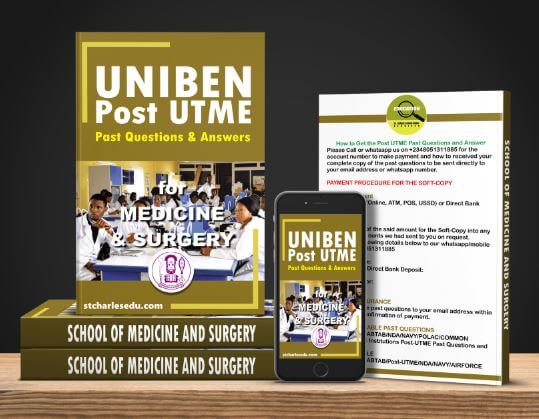Are you in the Faculty of Medicine, eligible for University of Benin Admission Screening Exercise, Also know as UNIBEN POST UTME, if yes, you need the Uniben Post UTME past questions for Medicine and Surgery, to enhance your preparatory skill in readiness to the exam.
we at stcharlesedu.com has compiled all UNIBEN Post UTME past questions for all department in the faculty of Medicine from 2005 – till date.
This past questions will give you an over-view and nature of the exams.
Past questions will not only help you know the likely questions but you will understand the nature of the examination.
Our research has confirm that candidate who seek admission into the faculty of Medicine and uses Uniben Faculty of Medicine Past Questions and Answer specifically to prepare for the Admission Screening Examination is ten times better than those who do not.
Read Also. Download UNIBEN Post UTME Past Questions for: Social Science, Arts, Management Science, Engineering, Pharmacy
Table of Contents
UNIBEN Post UTME Subject Combination for Medicine.
What are the Subjects Written in UNIBEN Post UTME for Medicine.
The subjects you will write in University of Benin Post UTME is same subjects you wrote in Jamb.

How to Get UNIBEN Past Question for Faculty of Medicine and Surgery.
To get the complete copy of the Past Questions, call or whatsapp me on 08051311885
Download UNIBEN Post UTME Past Questions for Faculty of Medicine free Sample
University of Benin, Benin City, Nigeria
POST-Unified Tertiary Matriculation Screening
Paper Type B.
Time Allowed 1hr 15min
SECTION II: GENERAL PAPER
1. a – Rattus rattus b -Agamaagama c – Bufo regularis d – Tilapia zilli.
The order of evolutionary advancement of the above vertebrates is.
(a) d – c – b – a (b) d – b – a – c (c) c – b – a – d (d) b – c – d – a.
2. Which of the following is likely to have higher concentration of mitochondria?
(a) white blood cell (b) egg cell (c) sperm cell (d) red blood cell.
3. Which of these diseases is not caused by virus?
(a) maize rust (b) Kinder pest (c) New’ castle (d) cassava mosaic.
4. Metabolic production of urea is carried out by the
(a) Kidney (b) Pancreas (c) Liver (d) spleen.
5. If a nursing mother is not producing enough milk, her hormonal system is probably deficient in.
(a) Prolactin (b) Oestrogen (c) Insulin (d) Thyroxine.
6. Nervous control differs from hormonal control in that the former.
(a) is a slower process (b) involves only chemical reaction (c) produce short-term changes (d) has no specific pathway
7. The two key captions involved in the action potential of nervous transmissions are.
(a) Mg2+ and K* (b) Na+ and Fe2+ (c) Na+ and K+ (d) Na+ and Mg2+.
8. A boy who is fond of swimming in a pond finds himself passing urine with traces of blood. He is likely to have contacted.
(a) Onchocerciasis (b) Poliomyelitis (c) Tetanus (d) Schistosomiasis.
9. The presence of a large number of mitochondria in a cell indicates that.
(a) it has little cytoplasmic content (b) the cell is dormant (c) the cell is very active (d) the respiration is poor.
10. If the cerebellum of a person is slightly damaged, which of the following will be impaired?
(a) vision (b) walking (c) digestion (d) breathing.
11. Herbs differ from shrubs because they.
(a) are only perennials (b) useful to herbalists (c) do not produce fruits (d) do not become woody.
12. Which of the following represents the evolutionary sequence in these plants?
(i) mango plant (ii) mosses (iii) spirogyra (iv) ferns (v) whistling pine.
(a) iii, ii, iv, v and i (b) iii, iv, v, i and ii (c) ii, iv, i, ii and v (d) iv, ii, iii, v and i.
13. By which process in man does oxygen pass from the alveoli of the lungs into the blood?
(a) excretion (b) osmosis (c) diffusion (d) transpiration.
14. The aspects of growth in living organisms include all the following processes except.
(a) reversible increase in size (b) increase in dry weight (c) increase in number of cells (d) irreversible increase in length.
15. Which of these excretory products is not found in mammals.
(a) Carbon dioxide (b) Mineral salt (c) ammonia (d) urea.
16. Which of the following organism is a producer.
(a) yeast (b) fungus (c) Rhizopus (d) spirogyra.
17. Changes in energy flow between organisms in a habitat can be represented by a.
(a) pyramid of biomass (b) flow chain (c) food web (d) Pyramid of energy.
18. Important abiotic factors which affect all plant and animals in the habitat are.
(a) rainfall and relative humidity (b) temperature and rainfall (c) salinity and relative humidity.(d) temperature and turbidity
19. Which of the following factors may not affect living organisms in an aquatic habitat.
(a) Light ‘ (b) Turbidity (c) pll (c) Humidity.
20. The accepted concept for the theory of Natural Selection does not include.
(a) tendency for organisms to overproduce (b) struggle for existence (c) survival of the fittest (d) Use and disuse of body parts.
21. Which of the following pairs of structure does not perform the similar function.
(a) Lungs and Spiracles (b) Root hairs and mammalian hairs (c) feathers and scales (d) contractile vacuole and kidney.
22. Which of the following is not an evidence of evolution?
(a) Anatomy (b) Genetics (c) Behaviour (d) Fossils.
23. Find the variance of the numbers K, K+I, K+2,
(a) 2/3 (b) 1 (c) K+l (d) (K+l)2.
surgery past questions
surgery exam questions
surgery post utme question
surgery exam question paper
Where are the answers